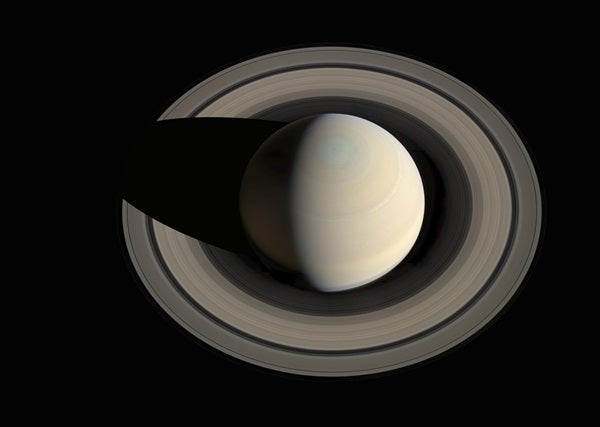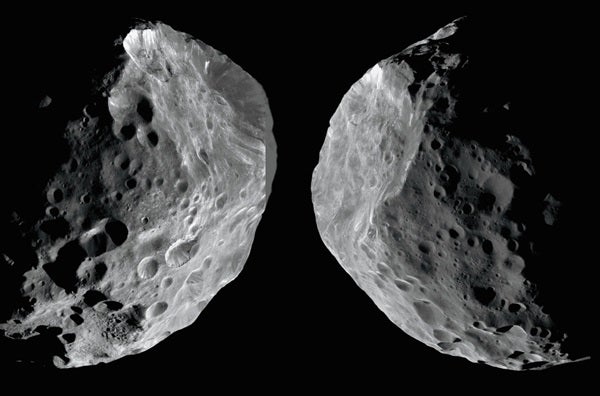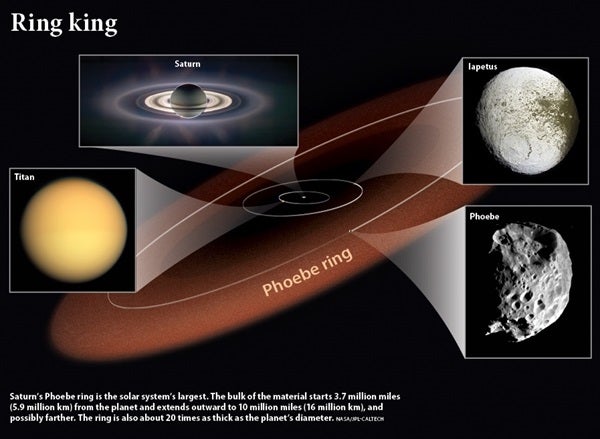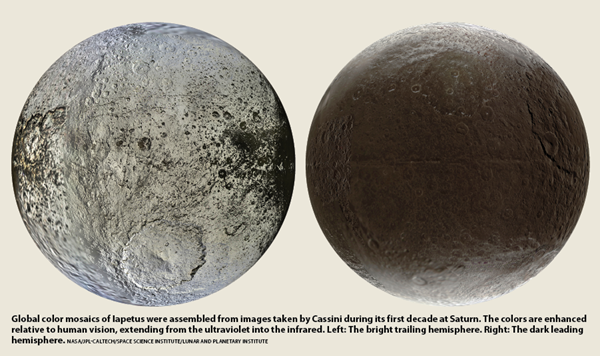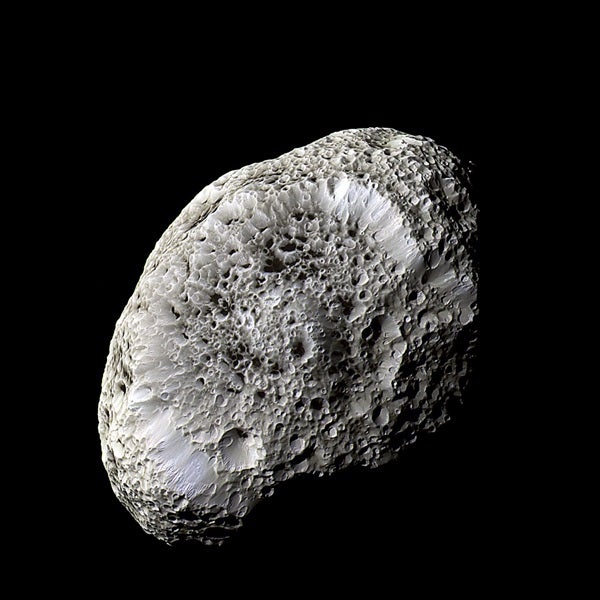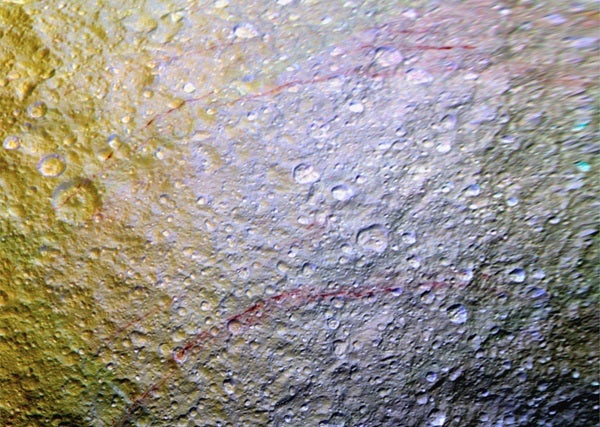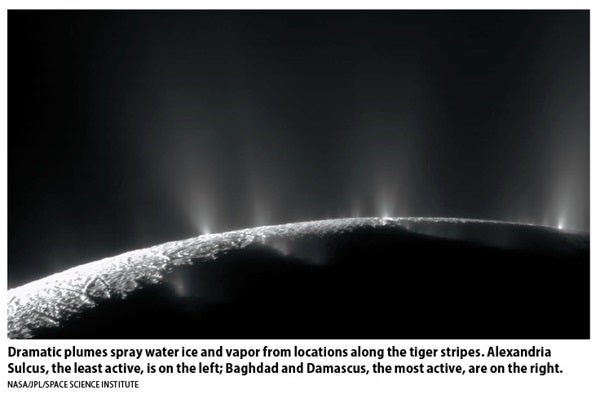But look again. Even Saturn’s small moons display some unusual dynamic relationships. For instance, Pan and Daphnis dwell in the Encke and Keeler ring gaps, respectively, where their gravity rumples the ring’s boundary and sweeps away particles to keep the gap clear. There’s Janus and Epimetheus, whose orbital differences are smaller than their diameters, so they should collide, but don’t. Instead, these “co-orbiting” moons effectively play leapfrog, swapping orbits over a four-year cycle.
Other small satellites orbit in the gravitational safe zones — called Lagrangian points — of the midsized moons Dione and Tethys. Lagrangian points are locations 60° in front of and behind a larger object’s orbit where a less-massive body can move in an identical stable orbit. Dione travels with Helene and Polydeuces, while Telesto and Calypso orbit along with Tethys — an arrangement thus far unseen among any other moons in the solar system.
And this is just for starters. “The Saturn system is full of surprises,” says Paul Schenk, a planetary geologist at the Lunar and Planetary Institute in Houston. There’s a satellite that likely originated in the Kuiper Belt, the storehouse of icy bodies beyond Neptune’s orbit; a piebald moon nearly encircled by an equatorial ridge containing some of the tallest mountains in the solar system; a spongy-looking tumbling satellite; and a moon that vents its subsurface sea into space, providing scientists with an unexpected potential niche for extraterrestrial life.
NASA’s Cassini mission took images as the spacecraft approached (left) and departed (right) Saturn’s moon Phoebe during its only close flyby of the satellite. Cassini passed just 1,285 miles (2,068 km) above the surface on June 11, 2004. Phoebe is thought to be a centaur that might have become a Jupiter-family comet, had Saturn not captured it.
The moon that came in from the cold
Phoebe was discovered in 1899 and is the first satellite found photographically. NASA’s Cassini spacecraft made its only close flyby of the distant moon June 11, 2004, about three weeks before slowing to enter orbit around the planet. At only about 130 miles (210 kilometers) across, Phoebe is about one-sixteenth the size of our Moon. Its heavily cratered surface is mostly dark as soot with no signs of resurfacing due to geological activity. But bright cliffs on the rims of the largest craters, as well as bright rays extending from smaller ones, reveal ice beneath a layer of dark material up to about 1,600 feet (490 meters) deep. Ground-based telescopes have detected the presence of frozen water, and Cassini’s instruments showed the presence of frozen carbon dioxide (dry ice) and organic material as well.
Phoebe orbits in the opposite direction of Saturn’s spin, on a path that is both more eccentric and more highly inclined than the planet’s inner moons. On the basis of these orbital characteristics, astronomers have long suspected Phoebe of being an interloper ensnared by the planet’s gravity, rather than a native to the Saturn system. Phoebe’s chemical makeup resembles C-type asteroids commonly found in the farthest regions of the main asteroid belt, while its density suggests an ice-rock mixture similar to Neptune’s moon Triton (itself thought to be a captured object) and Pluto.
In 2009, infrared observations by NASA’s Spitzer Space Telescope showed that Phoebe resides within a supersized, tenuous ring of ice and dust particles that had been previously undetected. “If you could see the ring, it would span the width of two Full Moons’ worth of sky, one on either side of Saturn,” says Anne Verbiscer, an astronomer at the University of Virginia, Charlottesville, who led the research. A 2015 study using data from NASA’s Wide-Field Infrared Survey Explorer found this king of rings extends even farther, starting 3.7 million miles (5.9 million km) from the planet and reaching at least 10 million miles (16 million km). Continual small impacts on Phoebe regularly eject dust that maintains the ring, while particles smaller than a few inches gradually migrate inward, likely the source for dark material found on the surfaces of other satellites, especially Iapetus.
A walnut and a tumbler
In 1671, Italian astronomer Giovanni Domenico Cassini discovered Iapetus, the next moon of Saturn as we move inward from Phoebe. He noticed that when Iapetus was on one side of Saturn, it was very bright, but on the opposite side, it nearly disappeared from view. He correctly proposed that Iapetus is tidally locked — meaning it always turns the same face to Saturn — just as our Moon is to Earth, and that the hemisphere centered on the direction of motion is covered with a dark material. Planetary scientists later named this dark feature Cassini Regio in his honor, as well as the Cassini mission.
At 927 miles (1,492 km) across, Iapetus is the third-largest moon of Saturn, and the planet’s only large satellite in a highly inclined orbit, which carries the moon in the same direction Saturn rotates, unlike Phoebe. Among the moons in the solar system that exhibit tidally locked rotation, Iapetus is by far the most distant from its planet. The moon’s density is only slightly greater than frozen water, indicating that rock makes up perhaps only one-fourth of its composition.
As Iapetus circles Saturn, dust migrating in the opposite direction from the Phoebe ring smacks into Cassini Regio like bugs on a windshield, but the shape of the dark patch can’t be fully explained by this simple accumulation of material. For one, the dark side of Iapetus is much redder than Phoebe.
On New Year’s Eve, 2004, the Cassini spacecraft approached Iapetus for the first time, and planetary scientists were enthralled with the images it returned.
The heavily cratered body showed numerous large impact basins — the largest in the Saturn system — but its standout feature was a conspicuous ridge running almost exactly along the equator, giving the icy moon the look of a walnut. The ridge extends over 800 miles (1,300 km) and cuts completely across Cassini Regio. In places, it breaks into isolated mountain peaks that may reach 12 miles (19 km) high, rivaling the giant martian volcano Olympus Mons but located on a world five times smaller.
There is nothing like it anywhere else in the solar system, and a completely satisfactory explanation of its origin eludes scientists. Did it erupt or grow from the inside, when Iapetus was young and its interior was still warm? Or is it the accreted remains of a ring either kicked up by an impact or formed when a small satellite passed too close and was crushed in the tides of Iapetus?
A 2014 study led by Erica Lopez Garcia at Brown University examined the topography of the ridge and found predominantly triangular slopes, much like what you’d get by slowly pouring sugar into a pile, suggesting an external source. But new models exploring possible internal formation mechanisms continue to appear. “I think more people favor the ring explanation, but the debate is still ongoing,” says Francis Nimmo, a planetary scientist at the University of California, Santa Cruz.
Supporting the ring interpretation are equatorial bulges on other moons in the system, especially Atlas, Pan, and Daphnis, which accumulate particles while orbiting in and near Saturn’s A ring. And then there’s Rhea, Saturn’s second-largest moon, which may or may not retain a tenuous ring today. “On Rhea, we found very unusual bluish spots along its equator, which are now interpreted as evidence for the re-accretion of a very thin ring of debris surrounding that moon in the not-so-distant past,” says Schenk.
Inward of Iapetus lies Hyperion, Saturn’s largest irregularly shaped moon, measuring 224 miles by 165 miles (360 km by 266 km). A 2005 Cassini flyby revealed a bizarre spongelike appearance, a single giant crater surrounded by a profusion of smaller ones, and about half the mean density of pure, solid water ice — one of the lowest-density materials in the outer solar system. This means Hyperion truly must be spongelike, full of tiny holes that greatly reduce its overall mass and surface gravity. Hyperion’s high fraction of pores helps it preserve older craters because more recent impacts eject less debris to cover them up.
Snow white
In 1981, Voyager 2 imaged parts of Enceladus, a midsized moon, at high resolution, revealing troughs, scarps, groups of ridges, and craterless plains — all types of terrain indicating internal forces had altered the surface comparatively recently in geological terms. “We knew there was something special about Enceladus because it reflects almost all the sunlight striking it. It had markings indicating it had an active geologic life,” says Ed Stone, project scientist for the Voyager missions. Such diversity was surprising for a satellite only 313 miles (504 km) across, leading some to suggest that Enceladus needed an unexpectedly large internal heat source to power these changes.
Soon after the flyby, researchers noticed that Enceladus orbits within Saturn’s broad, diffuse E ring, which extends from about 131,000 miles to 298,000 miles (211,000 km to 480,000 km) and thickens away from the moon. Ice grains in the E ring have limited survival times because of collisions with high-energy ions trapped in Saturn’s rotating magnetic field. This process, called sputtering, whittles away micrometer-sized ice grains in decades and breaks down smaller particles in just a few years. So for the E ring to exist, a regular supply of new grains must be ejected from Enceladus. In the early 1980s, several scientists suggested meteorite impacts, geysers, or volcanic eruptions as possible ejection mechanisms, but the matter remained speculative.
“Prior to Cassini, nobody would have anticipated that there was an ocean beneath the surface of Enceladus,” says Nimmo. “I think seeing actual geysers erupting was one of the biggest surprises in planetary science in recent memory.”
Due to mutual gravitational interactions, Enceladus orbits Saturn twice for every orbit of its more distant neighbor Dione. This orbital resonance forces Enceladus into a slightly eccentric orbit where tides heat the moon’s interior. “Tidal heating is slightly stronger at the poles anyway, so you might get a feedback loop: The polar region warms up, it becomes more deformable, giving rise to more tidal heating and so on,” Nimmo notes. “But why this only happened at the south pole is a mystery.”
There is certainly evidence that other parts of the surface were warmer in the past. Some impact craters look like they have flowed, indicating warm ice near the surface, and it seems fairly clear that different parts of Enceladus were heated at different times. “There are even features that look a bit like ancient tiger stripes, though this is controversial,” Nimmo explains. “It’s hard to tell from observations whether the activity was episodic, but the fact that you see heavily cratered and very lightly cratered areas, but not moderately cratered areas, suggests that activity was not continuous.”
Puzzling moons
While it’s hard to top Enceladus, the neighboring midsized moons Dione and Tethys tantalize planetary scientists with as-yet-unexplained features. “On Dione, a magnificent set of tectonic fractures was observed, some in a very pristine state of preservation,” says Schenk. A pair of unusual walled depressions in the moon’s smooth terrain might be volcanic vents; half of Dione’s surface is covered by what is likely ancient volcanic ice deposits; and some propose that Dione may possess a subsurface sea.
On Tethys, a huge rift zone named Ithaca Chasma runs nearly three-quarters of the moon’s circumference, and Cassini’s cameras detected a set of mysterious red arcs that appear to have formed very recently. “So while Enceladus has been stealing our attention, these moons have shown intermittent signs of activity, too,” Schenk adds.
On September 15, 2017, Cassini plunged into Saturn’s atmosphere, ending its mission. Scientists will be mining the data Cassini returned on these diverse worlds for decades to come. Even from the perspective of its smaller satellites, Saturn beckons. When will we return?

